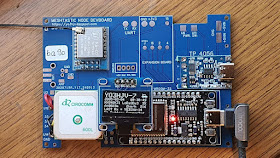After I played a little with my Meshtastic Development Board I previously made (and write about) I decided it will be nice to give it a try into LoRa APRS.
This raise some issues about how different modules are connected to the GPIO's of the ESP32 in my configuration.I was directed by some early adopters in Romania to the CA2RXU web flasher where I found that the Tracker FW can be loaded into a pretty good selection of boards.
But, what board from those would be compatible with my one? Hmmm.... this would require some research!
First, I had to go to CA2RXU's excellent repository and find some clues about pin mapping; how the LoRa transceiver is connected to the ESP32 on various boards in order to choose the proper version of the already compiled FW from the web flasher tool...
Yes, I could compiled it myself but, apart from being a brave ham, I like to cut corners because I'm a lazy one!
Using the already compiled FW will be a good "investment" because I can keep up with the future versions without going to the compiling process everytime a newer version is released.
Flashing the LoRa APRS I-Gate was easy and I already had one working on my bench but the tracker is a different animal because it needs the GPS input to really be usefull as a "tracker"!
So, I land onto the GitHub page of the project and searched for anything that could hint to my problem. Soon I found boards_pinout.h where various ready-made boards are described.
LoRa module is tied to the ESP32 using this diagram:
MISO > D19
MOSI > D27
NSS/CS > D18
SCK > D5
RST > D23
DIO0 > D26
so I searched for this particular definition.
I found two of them that could suit my needs.
First was the TTGO T-Beam family that catched my eye. Almost all of them have the LoRa transcever connected as I needed.
The main problem with the newer versions of the BOARD (!!!) have the battery management circuit APX192 and this is used for informations about the battery voltage.
Well, my board is reading the voltage with ESP32's ADC so, using the firmware could cause some problems. Or not. I don't want (yet) to explore the full code to see how APX192 is integrated into the workflow therefore I choose an early version, of T-Beam FW, the 0.7.








